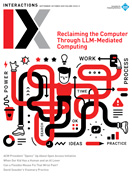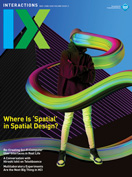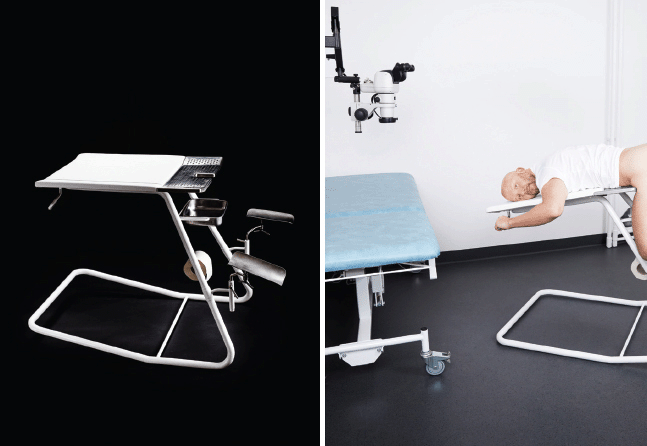Authors:
Karin Ehrnberger, Loove Broms, Cecilia Katzeff
Just over 10 years ago, Yolande Strengers wrote "Smart Energy in Everyday Life: Are You Designing for Resource Man?" an Interactions' cover story [1]. She launched the persona Resource Man (from now on referred to as RM) as the expression of the energy industry's conception of householders as rational and efficient micro resource managers. This persona is now well known in the HCI community and serves as an instrument in highlighting the need to design smart energy technology for all types of practices in the home with energy implications. Despite its power to fuel arguments for designing for other types of practices, identifying as an RM is quite attractive to many users as the persona possesses a high-status glow.
Since the appearance of RM, additional personas have emerged that represent visions serving different functions. They all expose narrowing, excluding, and diminishing values embedded in the narrative of the smart home. These personas fulfill important roles because they trigger discussions and enrich our language in pointing out societal threats. In this article, we dive deeper into the discussion by adding another persona to the gallery of stylistic tropes. Inspired by Sara Ahmed's figure Feminist Killjoy [2], we introduce the Smart Killjoy—a persona with a mission and agency to punctuate the utopian dream of a smart home.
→ We are introducing the Smart Killjoy, an activist persona with an intersectional agency, opposing the power structures maintained by smart energy technology.
→ As an extension of the Smart Killjoy's work, a norm-critical design approach has the potential to serve as a powerful tool to challenge the energy industry's visual dominance.
The Smart Killjoy does not only strive to make visible what is but also what is at risk of becoming. Since the industry uses this strategy to visualize something that may come to be, the critique of power must do the same. The Smart Killjoy critically analyzes the smart home from intersectional perspectives. With norm-critical design as its tool, it fights back with strong counterimages aiming to disrupt the very fantasy of the smart home's vision of happiness.
 The Vision of Smart Homes Is Exclusionary and Unsustainable
The Vision of Smart Homes Is Exclusionary and Unsustainable
Research from the past decade has provided substantial evidence exposing the narratives of the smart home as misleading and false. It indicates, for example, that such systems risk reinforcing gender roles, increasing household chores and unpaid work, worsening digital exclusion, compromising privacy, and facilitating increased abuse and domestic violence. In addition, recent findings show that smart home systems can appear discriminatory even to those whose interests and lifestyles align with the assumed norm.
The critique of smart homes also includes a problematization of the idea that smart homes are sustainable due to automation of the electric grid and energy efficiency. Although smart homes indeed can help reduce energy use in an individual household, their total energy use tells a different story. These systems require constant communication with centralized data centers that consume enormous amounts of energy. The vision depicts a world where objects in the home are connected to this type of data center and to one another, which not only presupposes an investment in numerous ubiquitous computational devices but also in the services that accompany them. Not only does the process maintain and reinforce a power relationship between industry and consumers, it also controls the relationships formed in the very production of these services [3]. It highlights how the automation of commercial services contributes to making the human labor that enables them invisible.
Smart home systems risk reinforcing gender roles, increasing household chores and unpaid work, worsening digital exclusion, compromising privacy, and facilitating increased abuse and domestic violence.
In summary, power-critical research on smart homes does not paint an optimistic vision of the future, but rather points to the grim reality and problems that are happening at this very moment. This reality describes the exact opposite of the vision that is conveyed by the industry. Yet the industry's vision of future homes has become dominant.
 Personas Substantiating the Critique
Personas Substantiating the Critique
A group of personas has been introduced within HCI literature to illustrate the critique of smart home narratives. RM [1] is an input to the discourse on how smart home systems promote the ideal of a data-driven, tech-savvy home energy manager interested in and capable of making effective resource management decisions. The promises of control, convenience, resource efficiency, and security through which the systems are marketed are tailored to and aimed at a certain type of consumer. At the same time, they can appear discriminatory and have entirely different consequences for others.
RM was accompanied in 2021 by the Smart Wife [SW; 4]. This persona embodies the emerging, feminized AI systems and voice assistants helping RM perform various functions in the household. Its purpose is to organize chores that women traditionally perform in the home. The SW's feminine voice and appearance of loyalty, reminiscent of a 1950s housewife, is described as a conscious strategy employed by the tech companies to lull consumers into believing these systems are secure and reliable. This makes the extra work that changes often bring invisible, raising expectations of how much to manage in a day and how a household should be organized.
Big Mother [5] is a persona that has the goal of opening up the black box of the smart home, thereby making visible its role as part of a larger political and economic system. Just as during the Industrial Revolution, the smart transition—though marketed with promises of more free time, greater convenience, and new experiences—gradually pulls people into new surveillance systems, emerging forms of automation, and expanding data markets. These shifts bring increased tensions and confrontations in everyday life, ultimately leading to more work rather than less.
Flexibility Woman [FW; 6] does not portray idealized visions from industry or critical perspectives on socioeconomic systems. Rather, it is a representation of women in low-income families grappling with attempts to reduce electricity use by managing and organizing everyday life for all household members. FW shows how an energy system that ignores gender and income differences runs the risk of reinforcing them.
As communicative characters, the personas reveal the dominant discourse that guides the development of smart homes. Furthermore, they show shortcomings in the system in terms of justice, equality, and energy efficiency. These emergent personas, however, call for an intersectional analysis to identify additional layers of power. Research highlights how a privileged gaze risks shaping the critical discourse about power. By identifying the SW as a white middle-class woman, Thao Phan illustrated that the nostalgic and idealized image of housework does not represent racialized histories of servitude [3]. On the contrary, the SW contributes to erasing power relations that, throughout history, have also manifested in gendered roles (e.g., the work done by maids, nannies, cooks, laundresses).
The privileged gaze shows how complex and multifaceted the vision of smart technology is and how challenging it is to expose and deconstruct. It is more important than ever not to rush toward solutions but to stay with the trouble and reveal the vision of smart homes in all its incarnations.
Where has the gallery of personas in the critique of the smart home taken us? The research literature is full of references to this critique and RM has become part of HCI researchers' common language. So, evidently, the persona gallery has led to an increased awareness and discussions. Devices and services, however, are still designed and marketed for a heteronormative, white, middle-class lifestyle. This is frustrating but also understandable. The gap of application, reflecting challenges in applying research results to societal needs, is more apparent than ever. By criticizing narratives of the smart home and future techno vision, researchers have managed to stir a debate within their own field as well as adjacent ones. We need a shift in criticality.
We must rely on foresight in our critical analysis of the smart home. But that also means these decisions are still being made, the shift is still underway. As new systems and relations are introduced, we have the opportunity to reevaluate what they (should) mean and how they (should) work [6].
How, though, can we actually influence those who hold the power to change things, but lack the justification to act? Is it enough to adhere to Sara Ahmed's saying, "We have to keep saying it because they keep doing it" [2]? Is that not what the power-critical research has done for a very long time, without any major changes? We definitely have to keep saying it, but it's time we also start doing it.
There is a need for a more activist approach, for someone who shows the downsides of RM's work and reveals the vision as a utopia. There is a need for a tool that kills hope of happiness because it disrupts the very fantasy of happiness. Ahmed's Feminist Killjoy is such a tool, a so-called complaint activist [2]. Ahmed argues that activism itself is knowledge production, that complaining and resisting teaches us about where it stings the most and that's where we need to go. In Ahmed's own words:
The figure of the feminist killjoy is a kind of institutional technology—a system of perception, a narrative trope, a power relation—that is deployed to deflect institutional failures, deny forms of structural violence and disadvantage, and project institutional and cultural problems onto those who dare to notice and speak of them. The feminist killjoy is thus a disciplinary technology, a figuration; those of us who speak against injustice, bias, and violence find ourselves quickly becoming her, becoming the problem. And we are told, she is the last thing you want to be [2].
We hereby introduce the Smart Killjoy (from now on referred to as SK) to the persona collection, an intersectional companion who monitors both the industry and the power-critical research and pays attention to the interpretive preferences that are made in the creation of meaning between these narratives. SK is a reminder that RM is a symptom of a sociotechnical system of power relations that constantly arise, overlap, and change. It is therefore fundamental to stay critical at the same time as we discuss solutions. As researchers are part of this system, it is also important to direct the critical gaze toward ourselves in order to leave room for others' perspectives.
With the help of norm-critical design, SK creates strong counterimages to the vision, which partly reveals the layers of power that govern the development of smart homes, as well as the risks that can arise if we do not take the power-critical research seriously. It is a power struggle that takes place behind the scenes of the smart home narrative, where people are excluded, oppressed, and endangered by definition. SK's primary interest is not to suggest ideas for inclusion, but rather to question who gets to have power and why. It's time to frame the narrative of smart homes as instruments of control and discrimination. This side of smart homes is something that, unlike a vision, already exists and risks causing even more serious consequences if it is not taken seriously. If the vision is maintained by making discrimination invisible, the vision is discrimination.
If happiness requires turning away from violence, happiness is violence [2].
In SK's eyes, smart homes are also a tool to greenwash the climate discourse by obscuring the consumer technology industry's responsibility in the system. Therefore, in addition to focusing on how smart home technology makes alternative energy-saving practices in households invisible, we will also explore how the dominant narrative makes the rebound effects of efficiency and the overall picture of the growing tech industry's total climate emissions invisible.
It's time to frame the narrative of smart homes as instruments of control and discrimination.
Contemporary power-critical research has shown that the vision of smart homes is, in fact, a utopia—an imagined ideal ecological and social sustainable lifestyle. The Utopia or Dystopia? fictional ad we created for smart home systems is inspired by findings from this research (Figure 1). The findings themselves, however, are not fiction: It's just another side of the story presented with the same marketing strategy that upholds the industry's utopia. With this in mind, it is interesting to discuss which story best depicts the smart home of the future. Which one is the utopia and which one is the dystopia? It all depends on whose gaze we adopt, whose story we choose to tell. A person who has been subjected to persecution, harassment, and control by someone using smart devices as weapons would perhaps find the fictional ad more truthful than the industry's utopia of a happy nuclear family. Maybe the perpetrator would find it more attractive. Together, the stories show two sides of the same coin, two worlds that run parallel and are shaped by each other. If we add more gazes, the coin becomes a prism, which, depending on how we point it at the light, reveals even more worlds.
 | Figure 1. Utopia or Dystopia? Norm-critical design in the form of a smart home advertisement. |
For design researchers, the power-critical approach combined with design is interesting because it is precisely in this encounter, between theory (academia) and practice (industry), where design researchers come from and work in. Designers possess great knowledge of product development and the importance of visual power, used by industry to market smart homes. These forces are so strong that the academic discourse, in comparison, becomes subordinate as it is accessible only to a very limited group. We live in a visual culture, and we consume images that are becoming more widespread than ever. We see a growing need to reinforce academic texts with visual material in order to improve visibility and accessibility of the power-critical research of smart homes. To create antitype-images that can compete with smart tech utopia, we must play in the same arena and use the same strategies that the industry uses to spread its messages.
 (Through) Norm-Critical Design
(Through) Norm-Critical Design
The norm-critical approach in design is a practice that originated in a Swedish design context, which aims to make the underlying sociopolitics of design visible. In this article we refer to norm-critical design in relation to the product design tradition. The first and second set of images (Figures 2 and 3) are examples of discursive design things: designed, physical artifacts that aim to reveal social norms reproduced by design, thereby provoking discussions. They represent examples of a norm-critical approach that involves swapping binary conditions (e.g., aesthetics, functions, practices, spaces) through design, thus revealing how our environment is shaped by stereotypical notions about different social groups. This approach also reveals an inherent hierarchy that, by extension, creates privilege for certain groups of people while discriminating against others. This discrepancy and the unequal conditions manifested through the artifacts appear almost ridiculous, while making it clear how we miss what is in between and beyond.
Norm-critical design research carried out by the authors of this article primarily aimed to reveal the white male gaze that characterizes various design solutions. Although our situated knowledge has imposed limitations in terms of both approach and analysis, the encounter with different audiences has shown how strongly the heteronomy shapes our view of other characteristics of discrimination. This shows how fundamental the white heteronomy is in society. To see the complexities of intersectional overlaps requires looking at phenomena from many different angles.
Norm-critical design has shown great potential as a tool for transforming theory into practice. The potential lies in the fact that the visual has the ability to concretize and make available what is otherwise perceived as complicated, unclear, or distant. This facilitates revaluations and renegotiations in the creation of alternative visions. The visual power of norm-critical design can thus contribute to strengthening the power-critical discussion within the energy and social science research and to spreading it outside the academic context.
 Unleashing the Smart Killjoy and Staying with Resource Man
Unleashing the Smart Killjoy and Staying with Resource Man
In this article, we have discussed how design research can contribute to concretizing and increasing accessibility to the power-critical discussion about smart homes by challenging the visual power of the industry. We have introduced the SK, a companion with an intersectional gaze, who aims to uncover the discourse of the smart home utopia by letting the norm-critical design process be shaped by a dystopian narrative of smart homes as a means of power, creating a socially and ecologically unsustainable future.
Strengers has suggested it's time to put RM to bed for good. But this hasn't happened. On the contrary, RM seems more vigorous than ever. Perhaps one of the reasons for this is that we have focused too much on RM as a representation of a human being and not a larger capitalist force, constantly creating new versions of itself at different levels. It is well known that companies use different strategies that claim to be both climate friendly and inclusive to gain power and money, while the underlying power structures remain hidden and intact. This creates no real change, just illusions. Putting RM to bed is the last thing we should be aiming for. Instead, we need to reveal RM's different guises, how they are maintained, and what their consequences are for different groups.
So, whose companion is SK? As we see it, it's up to each of us. SK is a way for us to draw attention to the power-critical researchers' need for a more intersectional perspective, as well as design researchers' need for broad knowledge and experience in challenging the commercial forces of design that contribute to maintaining the utopia. Happiness is an exclusionary practice. To make space for multiple voices, images, and dreams in the creation of future visions, this utopian notion of happiness must be dismantled wherever it appears. We invite all researchers with this as a common goal to explore the power of killing joy. Let's unleash the Smart Killjoy together.
1. Strengers, Y. Smart energy in everyday life: Are you designing for Resource Man? Interactions 21, 4 (2014), 24–31.
2. Ahmed, S. The Feminist Killjoy Handbook: The Radical Potential of Getting in the Way. Seal Press, 2023.
3. Phan, T. Amazon Echo and the aesthetics of whiteness. Catalyst: Feminism, Theory, Technoscience 5, 1 (2019), 1–39.
4. Strengers, Y. and Kennedy, J. The Smart Wife: Why Siri, Alexa, and Other Smart Home Devices Need a Feminist Reboot. MIT Press, 2021.
5. Sadowski, J., Strengers, Y., and Kennedy, J. More work for Big Mother: Revaluing care and control in smart homes. Environment and Planning A: Economy and Space 56, 1 (2024), 330–345.
6. Johnson, C. Is demand side response a woman's work? Domestic labour and electricity shifting in low income homes in the United Kingdom. Energy Research & Social Science 68 (2020), 101558.
Karin Ehrnberger has a Ph.D. in product and service design and is a researcher at KTH Royal Institute of Technology. With a foundation in design as a norm-critical practice, her main interest lies in studying the social and ecological implications of design and how they interrelate. [email protected]
Loove Broms has a Ph.D. in interaction design and is an associate professor in design at Konstfack and a researcher at KTH Royal Institute of Technology. Using an experimental design research approach, he conducts research in design and sustainability transitions with a particular interest in discursive artifacts, narratives, and meaning-making. [email protected]
Cecilia Katzeff is an associate professor in HCI at KTH Royal Institute of Technology. She is interested in the role of households, everyday life, and digital technology in the energy transition, especially the friction between environmental and social sustainability. [email protected]
 This work is licensed under Creative Commons Attribution International 4.0.
This work is licensed under Creative Commons Attribution International 4.0.
The Digital Library is published by the Association for Computing Machinery. Copyright © 2025 ACM, Inc.









Post Comment
No Comments Found